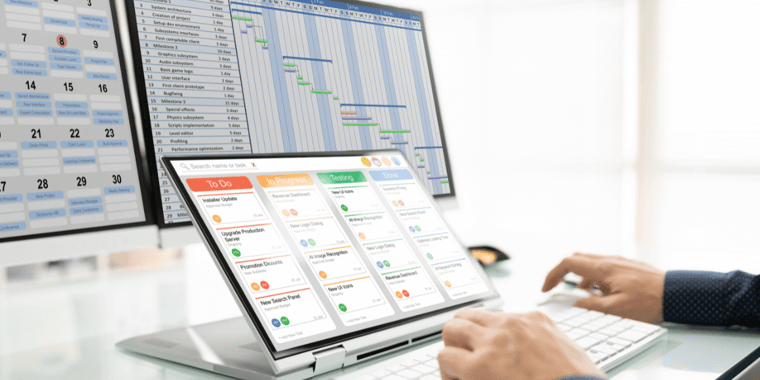Modern enterprise transformations are anything but simple. Today’s large-scale projects often span multiple departments, involve dozens of systems, and encompass both internal and external teams, each utilizing different methodologies. You may have your IT team sprinting in Agile, your finance department locked into a Waterfall cadence, and vendors operating within their proprietary delivery frameworks.
It’s no surprise that many projects struggle to stay coordinated, let alone deliver business value on time and within budget.
At Andrew Reise, we specialize in untangling that complexity. We’ve seen firsthand how large organizations succeed when they stop trying to force one methodology across the board and instead focus on building a unified work plan—one that gives everyone a clear line of sight to strategic milestones, dependencies, and outcomes.
In this blog post, we’ll walk through what it takes to bring multiple delivery frameworks under a single, integrated project management work plan without sacrificing speed, accountability, or agility.
What is the reality of hybrid projects?
In an ideal world, every stakeholder would use the same language, tools, and methodology. But in practice, large transformation efforts—especially those involving third-party vendors—rarely operate under a single model. We’ve seen enterprise clients running simultaneously:
- Scaled Agile Framework (SAFe) sprints on their development teams
- Waterfall milestone planning for finance and regulatory oversight
- Vendor-led hybrid approaches (often a mix of Agile scrums and traditional delivery gates)
Attempting to force conformity usually backfires. Teams end up disengaged, duplicate work emerges, and governance breaks down. Instead of trying to standardize methods, we help clients build a cohesive project-wide operating plan that integrates diverse approaches under a common reporting and decision-making structure.
How do you build an integrated project management work plan?
To build any integrated project management work plan, you need a high-level milestone framework that defines:
- Major phases (e.g., discovery, design, development, testing, rollout)
- Cross-functional dependencies and integration points
- Timelines for each track of work
- Governance checkpoints, such as go/no-go decisions and executive steering committee (ESC) reviews
Each workstream—regardless of methodology—ties into this structure by mapping its own deliverables, sprints, or activities to the shared project timeline. This provides the project management office (PMO) with visibility into where teams are headed, when key inputs are due, and what potential risks or delays might arise.
Workstream-Level Autonomy with Top-Down Coordination
We allow teams the flexibility to operate within their preferred frameworks, provided they:
- Report status in terms of defined project milestones.
- Surface blockers that impact other teams.
- Participate in shared planning and review cycles.
This balance allows for agility at the execution level while maintaining strategic alignment at the project level.
How do you “walk the wall” for visual management at scale?
One of our go-to techniques for aligning complex projects is a tool we call “walk the wall.” Initially used in an enterprise insurance transformation, this visual method maps the entire work lifecycle across all teams and phases on a shared board, whether physical or digital.
Each workstream charts:
- Planned deliverables
- Sprint or milestone dates
- Interdependencies with other tracks
- Current status and risk flags
These boards are reviewed in recurring cross-functional meetings. Teams "walk the wall" together to call out alignment issues, scope changes, or timeline risks. It turns abstract plans into tangible discussions and creates immediate visibility for leadership.
This method works particularly well when:
- Rolling up dozens of agile sprints into a consolidated release timeline
- Coordinating a vendor-led rollout across multiple geographies
- Managing test readiness across multiple integrated systems
What does cross-methodology governance involve?
The key to integrating diverse workstyles is governance that cuts across methodologies without becoming a bottleneck. A unified work plan must include shared routines, such as:
- Weekly status calls with all workstream leads
- ESC reviews tied to business case milestones
- Risk and issue logs with clear ownership and escalation paths
- Scorecards that report progress in business-relevant terms, not just sprint velocity or budget burn
In one recent transformation effort, our client had three main vendors, each using a different delivery model. By building a shared governance cadence and scorecard format, we enabled its executive team to assess progress holistically, regardless of individual methodology.
What are the benefits of unified planning?
The return on investment for a unified work plan goes well beyond coordination. It creates:
- Strategic visibility: Leadership can see the whole forest, not just individual trees.
- Risk predictability: Interdependencies and bottlenecks are flagged early.
- Improved accountability: Every team sees how their work contributes to the whole.
- Accelerated decision-making: With aligned data and reporting, decisions happen faster.
In a past retail engagement, this approach helped the client identify a major misalignment between marketing and IT timelines weeks before the go-live date. Without unified planning, that disconnect could have caused a customer-facing failure.
How do you manage a project with Agile, Waterfall, and SAFe teams together?
Hybrid work plans are most effective when accompanied by a centralized milestone roadmap that’s paired with methodology-specific autonomy and consistent reporting.
Let’s examine a past engagement where an enterprise client was rolling out a nationwide customer experience platform across more than 500 service locations. The initiative involved:
- A third-party vendor delivering the platform using Agile
- An internal IT team managing integrations using Waterfall
- A change management track operating on monthly cadence plans
Rather than forcing everyone into a single framework, we created a milestone-based plan that each track could map to. Agile sprints were translated into delivery targets, while Waterfall phases were mapped to dependency checkpoints, and change activities were aligned with parallel communication workstreams.
Using visual tools and shared scorecards, the PMO coordinated planning sessions, tracked progress, and surfaced risks through integrated status dashboards. The outcome? A platform went live on schedule, with minimal disruption and clear stakeholder visibility throughout the process.
Check out more customer success stories to learn about our project management services!
What is the PMO’s role in hybrid environments?
The PMO plays a pivotal role in unifying methodologies. It becomes:
- The translator between different planning languages
- The convener of cross-functional reviews
- The guardian of enterprise-level outcomes over methodology preferences
By focusing on milestones, interdependencies, and business outcomes rather than tools and terminology, the PMO empowers teams to do their best work—without working in silos.
Unified planning is strategic planning.
A truly unified work plan doesn’t require every team to use the same methodology. It requires a shared understanding of outcomes, transparency into progress, and a governance structure that keeps everyone focused on what matters most: delivering business value.
Whether you're launching a new platform, implementing contact center AI, or overhauling customer journey tools, your ability to align execution across methodologies will determine your project's success.
Bring clarity to your complex transformation with Andrew Reise. Contact us today to build a unified work plan that works for every team and delivers results.


